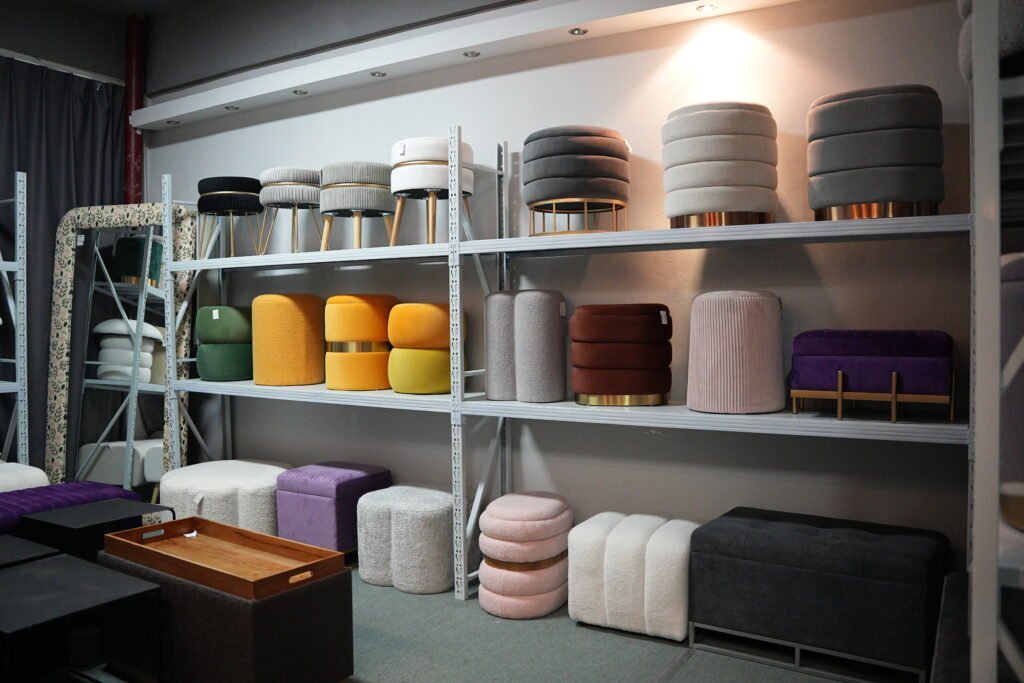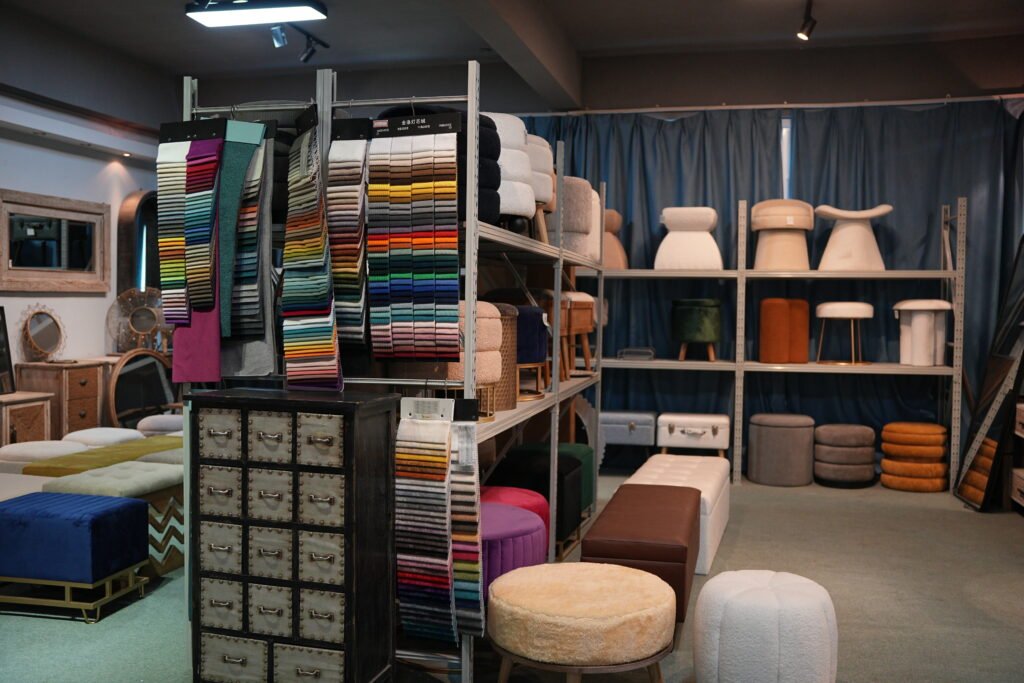Ottomans are versatile furniture pieces that serve both functional and decorative purposes in any room. Whether you’re using them as a footrest, extra seating, or even as a storage solution, selecting the right material for your ottoman is crucial. With a wide range of materials available, from luxurious velvet to durable leather, it can be overwhelming to decide which is best for your needs.
This article provides a comprehensive guide for buyers on choosing the right material for ottomans, focusing on velvet, PU, and other fabrics. It covers the aesthetic appeal and functionality of various materials, highlighting how each suits different interior designs and customer needs. Velvet ottomans add luxury, while PU offers durability and practicality. Fabric ottomans are versatile and affordable, while rabbit fur adds a cozy, high-end touch. Buyers should consider target customer preferences, from high-end buyers seeking luxury materials to budget-conscious buyers who prefer affordable options. The guide emphasizes matching materials with interior design themes.
Understanding the Different Ottoman Materials
Ottomans come in a variety of materials, each with its own aesthetic appeal and functionality. Here’s a breakdown of some of the most popular materials used for ottomans:
Fabric Ottomans
Fabric ottomans are a popular choice for homeowners and buyers due to their versatility and affordability. The range of fabric options for ottomans includes cotton, linen, polyester blends, and more. These fabrics are soft to the touch, easy to clean, and can be dyed in virtually any color, offering endless possibilities for customization.
- Visual Appeal: Fabric ottomans tend to have a softer, more casual appearance. The texture can range from smooth to slightly textured, offering a wide variety of design options.
- Comfort: Fabric ottomans are typically more comfortable compared to leather due to their softness, making them an ideal choice for spaces where comfort is a priority, like living rooms or bedrooms.
- Durability: Fabric is generally less durable than leather, but modern fabric treatments have made many types of fabric highly resistant to stains and fading.


Velvet Ottomans
Velvet is a luxurious fabric known for its rich texture and sophisticated look. Velvet ottomans are often used in high-end or stylish spaces, adding a touch of elegance and luxury. Velvet is a material that immediately draws attention and can become a statement piece in any room.
- Visual Appeal: Velvet ottomans have a soft, opulent sheen that adds depth and texture to the space. The rich colors and plush feel make them ideal for formal or traditional settings.
- Comfort: Velvet is a soft fabric that feels plush and comfortable to the touch. It’s great for decorative purposes but also offers functional comfort as a footrest or extra seating.
- Durability: While velvet offers unmatched beauty, it can be more prone to wear and tear, especially in high-traffic areas. It’s also more susceptible to stains, which may make it less practical for households with pets or young children.
Rabbit Fur Ottomans
Rabbit fur ottomans offer a unique and luxurious texture that adds warmth and elegance to a room. While not as common as velvet or leather, they’re a statement piece that can add a touch of glamour and coziness to any space.
- Visual Appeal: Rabbit fur ottomans have a distinctive, soft, and fluffy texture that enhances the tactile experience of a room. The natural sheen of the fur and its soft feel create a sophisticated and cozy atmosphere.
- Comfort: Rabbit fur ottomans offer exceptional comfort and warmth, making them ideal for colder climates or spaces designed for relaxation.
- Durability: Fur can be delicate and require special care to prevent damage. Fur ottomans may not be suitable for high-traffic areas or homes with pets, as the fur can become matted or dirty over time.


PU Ottomans
PU is a timeless and highly durable material that is often used for high-end, classic ottomans. Leather ottomans exude sophistication and offer lasting quality that improves with age. They are a popular choice for both residential and commercial spaces due to their durability and upscale appearance.
- Visual Appeal: Leather ottomans have a sleek, polished look that can range from matte to glossy finishes. They add a refined and elegant touch to any room and are often used in more formal or contemporary spaces.
- Comfort: Leather can feel cool to the touch initially but softens and conforms to the body over time. It may not be as plush as velvet, but it offers a smooth, comfortable seating surface.
- Durability: Leather ottomans are highly durable and can withstand heavy use. They are resistant to staining and can be cleaned easily, making them ideal for high-traffic areas and homes with pets or children.
Other Ottoman Materials
Beyond the classic fabric, velvet, rabbit fur, and leather, ottomans can be made from a variety of other materials, such as:
- Suede: A softer, more textured version of leather, suede ottomans offer a unique feel and appearance. They are more prone to stains and damage than regular leather, but they can add an inviting warmth to a room.
- Wood and Metal: Some ottomans incorporate wood or metal frames with upholstered tops, combining the durability of the frame material with the softness of the upholstery. These ottomans are often used as part of modern, industrial, or transitional designs.
- Faux Leather: Faux leather ottomans provide the look of leather at a lower cost. They are a good alternative for buyers on a budget but may not offer the same durability or luxurious feel as real leather.


How Materials Differ in Terms of Aesthetics and Functionality
When choosing the material for your ottoman, it’s important to consider how the material aligns with your desired aesthetic and function. Here’s how each material stacks up in terms of both:
Visual Differences
- Fabric: Offers a soft, casual look and comes in a wide range of colors and patterns. It’s perfect for creating a cozy, laid-back environment.
- Velvet: Provides an elegant, luxurious aesthetic. The sheen and texture of velvet ottomans make them perfect for formal or traditional spaces.
- Rabbit Fur: A soft, unique texture that adds warmth and a luxurious feel. It’s ideal for spaces that aim to evoke a cozy, glamorous vibe.
- Leather: Sleek, refined, and timeless. Leather ottomans provide a polished, upscale look that’s perfect for both modern and classic interiors.
Functionality Considerations
- Fabric: Easy to clean and maintain, but may not be as durable as leather, especially in high-traffic areas.
- Velvet: Requires more care to maintain, as it can stain easily. Velvet is better suited to lower-traffic areas or spaces where aesthetics are the main priority.
- Rabbit Fur: While incredibly luxurious, fur ottomans are not the most practical in high-traffic areas. They are better suited for decorative purposes or quieter spaces.
- Leather: Extremely durable, easy to clean, and resistant to stains. Leather ottomans are ideal for high-traffic spaces and homes with pets or children.
Matching Ottoman Materials with Different Interior Designs
The material of your ottoman plays a key role in how it complements your room’s interior design. Here’s a look at how different materials can be matched with various design themes:
Modern and Minimalist Design
For a sleek, modern look, opt for PU or metal-framed ottomans. These materials work well in minimalist spaces where clean lines and neutral colors dominate. Faux leather is also a great choice for budget-conscious buyers looking for a modern look without the high price tag.
Traditional and Classic Interiors
If you’re designing a more traditional room, velvet or fabric ottomans in rich, deep colors are ideal. PU ottomans in a more classic finish also work well in these spaces, adding a refined touch without being too flashy.
Boho and Eclectic Style
For bohemian and eclectic spaces, rabbit fur ottomans or fabric pieces with intricate patterns and textures are perfect. These materials offer a playful, relaxed vibe that fits well with the eclectic mix of colors and designs typically found in boho interiors.
Contemporary and Industrial Spaces
In modern or industrial settings, metal and suede ottomans work well. The clean, structured lines of metal-framed ottomans blend seamlessly with urban, industrial decor, while suede ottomans add a softer texture that still complements contemporary designs.


How to Choose the Right Ottoman Material for Your Target Audience
When selecting an ottoman material, consider your target customer base. Whether you’re buying for a high-end market or a budget-conscious audience, the material you choose will play a large role in your sales. Here are some considerations for different customer types:
High-End Buyers
For upscale markets, materials like velvet, leather, and rabbit fur are ideal. These materials exude luxury and are highly sought after in premium residential and commercial markets. Buyers seeking high-end ottomans are often willing to pay more for quality, aesthetics, and durability.
Budget-Conscious Buyers
For buyers on a budget, fabric and PU ottomans are practical and affordable options. These materials can still offer a stylish and functional ottoman but at a lower price point. Fabric ottomans come in a variety of colors and patterns, making them versatile for many different design themes.
Families with Children and Pets
Leather ottomans are the best option for homes with children or pets due to their durability, ease of cleaning, and resistance to stains. PU and fabric ottomans with stain-resistant treatments are also good options.
Conclusion
Choosing the right material for your ottoman requires careful consideration of both aesthetics and functionality. Whether you’re designing a high-end space with luxurious velvet or selecting a durable leather ottoman for a family home, the material you choose will impact both the look and the longevity of your piece. By understanding the visual and functional differences between materials like fabric, velvet, rabbit fur, and leather, you can make an informed decision that aligns with your design goals and customer needs.
If you are a buyer looking for the products mentioned in the article, you can inquire with Teruier, click here to browse some of Teruier’s products. You can also read Teruier’s brand story by clicking here.


